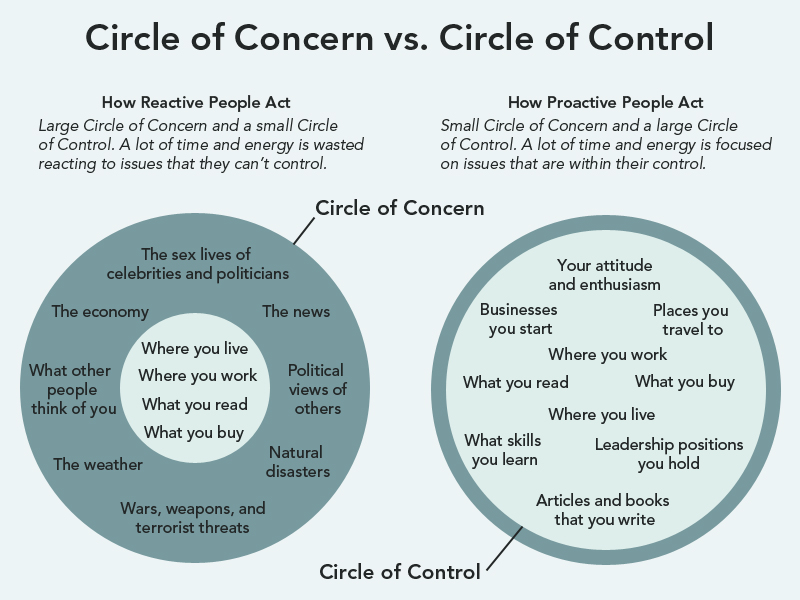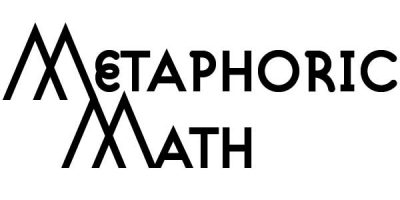Geometry lesson of the day: Concentric Circles consist of two or more circles that fit inside one another and share a center point but have different radius lengths. A target or bullseye is a common example of concentric circles, where attention is directed to the smallest circle surrounding the center.
If you’ve read Stephen Covey’s foundational book The Seven Habits of Highly Effective People, you may remember his use of circles to illustrate the first habit: Be Proactive. I first read this book years ago and recently began reviewing Covey’s wise words as I plan to devote a significant portion of the 2020 Math Project to the study of habits.
The circle is a beautifully balanced geometrical shape where all points are equidistant from the center and is widely used in a variety of diagrams to illustrate elements and data sets. You can be sure that I will explore a variety of these geometric forms in the coming year.
The basic principle of Covey’s circles lies in separating proactive vs. reactive, and choosing to focus your attention on the things you can take direct action to influence and control instead of wasting time and energy on the things which may concern you but are beyond your control.

This paradigm shift is a game changer, and I can attest that it feels very empowering to free up your creative bandwidth by being intentional about the content you consume. Our world is incredibly noisy, with so many people shouting from various platforms about their views on politics, the environment, the economy, the news, the weather, and more, all vying for our attention with their tools of persuasion. And sure, there are many good points to be made about important issues that have relevant impacts on our lives. But, how much time and energy are you spending each day being distracted and/or emotionally triggered by topics that you can exert minimal control over, whether as a crusader or disciple or critic?
The wisdom in Covey’s teachings lies in redirecting one’s focus to the core circle of control and expanding its relative area to dwarf the outer circle, and actually use your time and energy wisely to affect change about the things you care about. Not only does this approach increase productivity and effectiveness, but it also has great potential to increase happiness.
The Circle of Control also lends itself to a focus on mindfulness and living in the moment. You can’t control the past or the future, so there is no sense in devoting energy to regrets or anxieties that are beyond your influence. Hindsight is only 20/20 if you can see beyond the mistakes and failures to proactively uncover lessons that can be applied going forward. This approach can effectively turn a failure into a success.
I created a noticeable and welcomed shrinking of my Circle of Concern when I disconnected from most social media about 6 months ago. It freed up my focus to read more books and become more intentional about how I spend my time. While I am in the early stages of reintroducing social media use with the creation of this blog, I am choosing to be more selective about how I curate my feeds along with setting limits on the frequency and time I spend scrolling. The social media habit can be a serious time pit, and after months of living without it, I can say I’d rather prioritize the new reading habits I gained in its place. My increased bandwidth has sparked a fresh inspiration to write and create this blog project alongside a desire to share what I’ve learned with others.
And speaking of habitual behaviors, James Clear (who created the graphic above) wrote the bestselling book Atomic Habits, which happens to be next up on my reading list. Coincidently, when I was in the midst of writing this post and went looking for an image of the circle of influence, I landed on the image he created along with his excellent article about being intentional with the content we consume. THEN, I clicked on his About page and found this quote, no joke: (This is all after I wrote the opening few paragraphs; coincidence or synchronicity?!)
I believe the best way to change the world is in concentric circles: start with yourself and work your way out from there. If you get yourself sorted out, then that is one less person for the world to worry about. You’ll be in a position to contribute rather than consume. You will add order rather than disorder.
-James Clear
Here’s to changing the world, one habit at a time!

